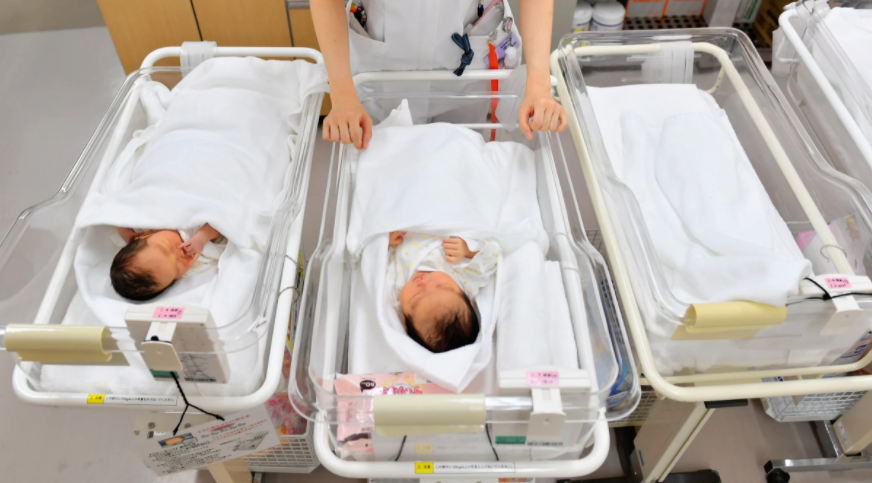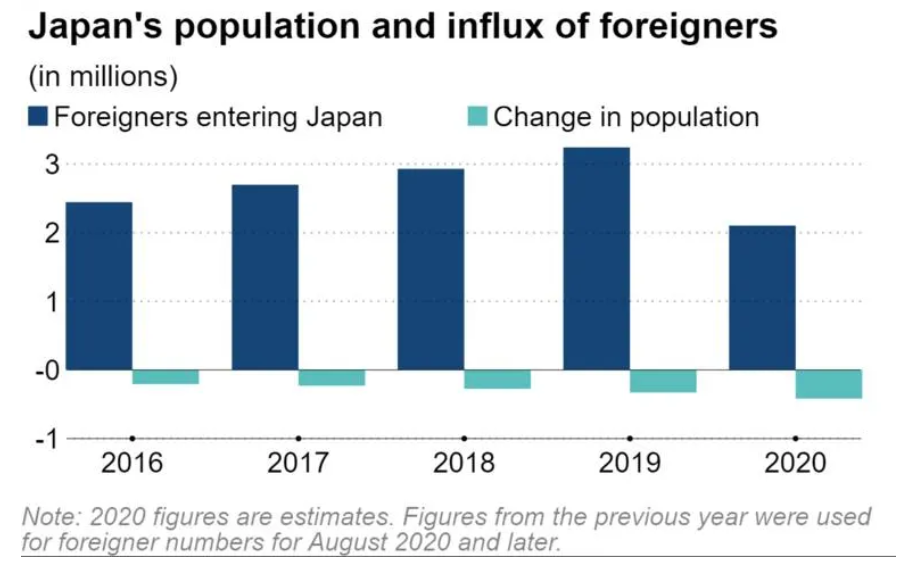 奇怪的新闻让外国人纷纷吐槽:日本人口急剧下降,因为大流行使外国人远离日本
奇怪的新闻让外国人纷纷吐槽:日本人口急剧下降,因为大流行使外国人远离日本
Japan sees steep population drop as pandemic keeps foreigners away
译文简介
日经NIKKEI ASIA:因为疫情原因,导致大量的外国人不能到日本,从而使日本人口急剧下降。
正文翻译

TOKYO -- Japan's population shrank by a record 420,000 people last year, government estimates show, as the coronavirus pandemic dealt a heavy blow to an influx of foreign workers that had helped offset the country's ongoing natural population decline.
东京——政府估计,去年日本人口减少了创纪录的42万人,因为冠状病毒大流行对外国工人的涌入造成了沉重打击,帮助抵消了该国持续的自然人口下降。
The total fell for a 12th straight year, shattering the previous record of 329,000 set just a year earlier. The health ministry estimates Japan's population at 125.57 million as of Jan. 1, based on confirmed data through July and estimates based on births, deaths and foreign arrival and departure data.
总数连续第12年下降,打破了一年前创下的32.9万人的纪录。日本厚生省估计,截至1月1日,日本人口为1.2557亿,这是根据截至7月的确认数据以及出生、死亡和外国入境和离境数据估算得出的。
总数连续第12年下降,打破了一年前创下的32.9万人的纪录。日本厚生省估计,截至1月1日,日本人口为1.2557亿,这是根据截至7月的确认数据以及出生、死亡和外国入境和离境数据估算得出的。
The drop owes in large part to a 60% plunge in foreign arrivals that has kept the labor market tight even though the pandemic has slowed the economy and eliminated many jobs.
这一下降在很大程度上是由于外国移民数量锐减了60%,这使得劳动力市场保持紧张,尽管这一流行病已经减缓了经济增长,并消除了许多就业机会。
这一下降在很大程度上是由于外国移民数量锐减了60%,这使得劳动力市场保持紧张,尽管这一流行病已经减缓了经济增长,并消除了许多就业机会。
The natural rate of decline -- or the difference between births and deaths -- was about on par with 2019 during the first seven months of the year. But net foreign arrivals to the country tumbled more than 40% over that period to 115,000 amid entry restrictions aimed at curbing the spread of the virus.
自然下降率(即出生和死亡之间的差异)与今年前7个月的2019年基本持平。但是,由于旨在遏制病毒传播的入境限制,到日本的外国净入境人数在此期间下降了40%以上,达到11.5万人。
自然下降率(即出生和死亡之间的差异)与今年前7个月的2019年基本持平。但是,由于旨在遏制病毒传播的入境限制,到日本的外国净入境人数在此期间下降了40%以上,达到11.5万人。
The influx of foreign workers in recent years had alleviated labor shortages in a range of industries, including restaurants, convenience stores, manufacturing and construction.
近年来外国工人的涌入缓解了包括餐馆、便利店、制造业和建筑业在内的一系列行业的劳动力短缺。
近年来外国工人的涌入缓解了包括餐馆、便利店、制造业和建筑业在内的一系列行业的劳动力短缺。
"If the inflow of foreigners continues to be disrupted, the labor shortage will quickly worsen," said Takuya Hoshino of the Dai-ichi Life Research Institute.
第一生命研究所的Takuya Hoshino说:“如果外国人的流入继续受到干扰,劳动力短缺将迅速恶化。”。
第一生命研究所的Takuya Hoshino说:“如果外国人的流入继续受到干扰,劳动力短缺将迅速恶化。”。

标题是:日本人口和涌入的外国人 (百万计)
注: 蓝色的是外国人进入日本数 绿色是人口变化
Data from the Bank of Japan shows that employers remain short-handed despite the pandemic.
日本央行(bankofjapan)的数据显示,尽管流感大流行,雇主仍然人手不足。
日本央行(bankofjapan)的数据显示,尽管流感大流行,雇主仍然人手不足。
In the December edition of the quarterly Tankan survey of business sentiment, the diffraction index of employment conditions came in at minus 10, indicating that more companies said employment is "insufficient" than "excessive." Readings were negative in all 12 nonmanufacturing industries, particularly construction, information services and retail.
在12月份的Tankan商业信心季度调查中,就业状况的绕射指数为-10,表明更多的公司表示就业“不足”而不是“过度”。12个非制造业的数据均为负值,尤其是建筑业、信息服务业和零售业。
在12月份的Tankan商业信心季度调查中,就业状况的绕射指数为-10,表明更多的公司表示就业“不足”而不是“过度”。12个非制造业的数据均为负值,尤其是建筑业、信息服务业和零售业。
Even the hard-hit restaurant and hotel industry reported a labor shortage, with a reading of minus 3, after spending June and September in surplus territory, though it may have swung back in the other direction during the current state of emergency.
即使是遭受重创的餐饮业和酒店业也报告称,在6月和9月的盈余地区度过之后,劳动力短缺指数为负3,不过在目前的紧急状态下,该行业可能已经转向了另一个方向。
即使是遭受重创的餐饮业和酒店业也报告称,在6月和9月的盈余地区度过之后,劳动力短缺指数为负3,不过在目前的紧急状态下,该行业可能已经转向了另一个方向。
The entry of foreign workers is expected to pick up again once vaccines and other measures quell the outbreak. But "wages are rising in China and elsewhere, so it's not clear if there will be as many [people] coming to Japan as before," Hoshino said.
一旦疫苗和其他措施平息疫情,外国工人的入境人数预计将再次回升。但Hoshino说:“中国和其他地方的工资都在上涨,所以不清楚来日本的人是否会像以前一样多。”。
一旦疫苗和其他措施平息疫情,外国工人的入境人数预计将再次回升。但Hoshino说:“中国和其他地方的工资都在上涨,所以不清楚来日本的人是否会像以前一样多。”。
This year is expected to see a significant drop in birth rates. Reported pregnancies fell 5.1% on the year to about 727,000 for the 10 months through October, according to the health ministry, with a particularly steep decline starting in May.
预计今年出生率将大幅下降。据卫生部统计,截至10月份的10个月内,报告的怀孕率同比下降5.1%,至72.7万人左右,其中5月份开始下降尤为明显。
预计今年出生率将大幅下降。据卫生部统计,截至10月份的10个月内,报告的怀孕率同比下降5.1%,至72.7万人左右,其中5月份开始下降尤为明显。
Dai-ichi Life Research and the Japan Research Institute both see births falling below 800,000, beyond 2019's record low of 865,000. The accelerated population decline may continue into next year.
第一生命研究院和日本研究院都预计出生率将降至80万以下,超过2019年的最低纪录86.5万。人口的加速下降可能会持续到明年。
第一生命研究院和日本研究院都预计出生率将降至80万以下,超过2019年的最低纪录86.5万。人口的加速下降可能会持续到明年。
评论翻译
很赞 ( 4 )
收藏
Is it just me or did this article strike anyone else as somehow utterly bizarre?
Soo, births are down due to the lack of foreigners coming into the country?
Not to put too fine a point on this, but...
Because there aren't enough tourists and foreigners coming into Japan, there aren't enough Japanese women getting pregnant????
Please tell me that I'm somehow reading this wrong...
[edit] The best way I can read this is that the only reason Japan's population is remotely breaking even, is because of the influx of foreign workers immigrating and having kids.
Still, the whole tone of this article feels really weird...
好吧。。。
仅仅是我还是其他人觉得这篇文章有点奇怪?
所以,出生率下降是因为没有外国人入境吗?
不要把太多放到这个点上,但是。。。
因为没有足够的游客和外国人来日本,没有足够的日本妇女怀孕????
请告诉我我看错了。。。
[编辑]我能读到这篇文章的最好的方式是,日本人口远未达到收支平衡的唯一原因,是大量外国工人移民和生孩子。
尽管如此,这篇文章的整个基调还是让人觉得很奇怪。。。
原创翻译:龙腾网 https://www.ltaaa.cn 转载请注明出处
A number of these foreigners probably returned to their countries, and they couldn't be replaced because of entry bans. So it represents a net population loss for the labor market. This is compounded by the fact that the Japanese population is naturally declining, and this year in particular had a decreased birth rate (due to fears of covid? economic uncertainty? unsure).
我认为外国人不来的原因更多的是,相当数量的外国工人在日本生活了一段时间(通常是1-3年),他们在这里生活的同时,也被视为劳动力市场的一部分(因为他们在工作/学习)。
其中一些外国人可能返回了他们的国家,由于入境禁令,他们无法被替换。因此,它代表了劳动力市场的净人口损失。日本人口自然在下降,特别是今年出生率下降(因为担心新冠?经济不确定性?不确定)。
(笔者注:试图挽尊。。)
So yeah, it's a bit of a mess that dumps a bunch of numbers without much needed context.
我也很困惑。也许他们也包括他们的外国居民?但奇怪的是,报告指出,出生率显著下降,却没有将其置于单独的背景下。
所以是的,这是一个有点混乱,倾倒了一堆没有什么用的数字。
原创翻译:龙腾网 https://www.ltaaa.cn 转载请注明出处
No, it's because Japanese people in general have a low birth rate, and that has been offset by immigrants coming in (and those immigrants bringing their children or having children with other immigrants). Because of the pandemic, immigration has dropped (in fact foreigners aren't allowed in at all right now), so the population (which includes immigrants) is also dropping.
因为没有足够的游客和外国人来日本,没有足够的日本妇女怀孕????
不,这是因为日本人的出生率一般都很低,而移民的到来(以及那些带着孩子或和其他移民生孩子的移民)抵消了这一点。由于流感大流行,移民人数减少了(事实上,现在外国人根本不允许入境),所以人口(包括移民)也在下降。
笔者注:这是日经 nikkei asia的报道。